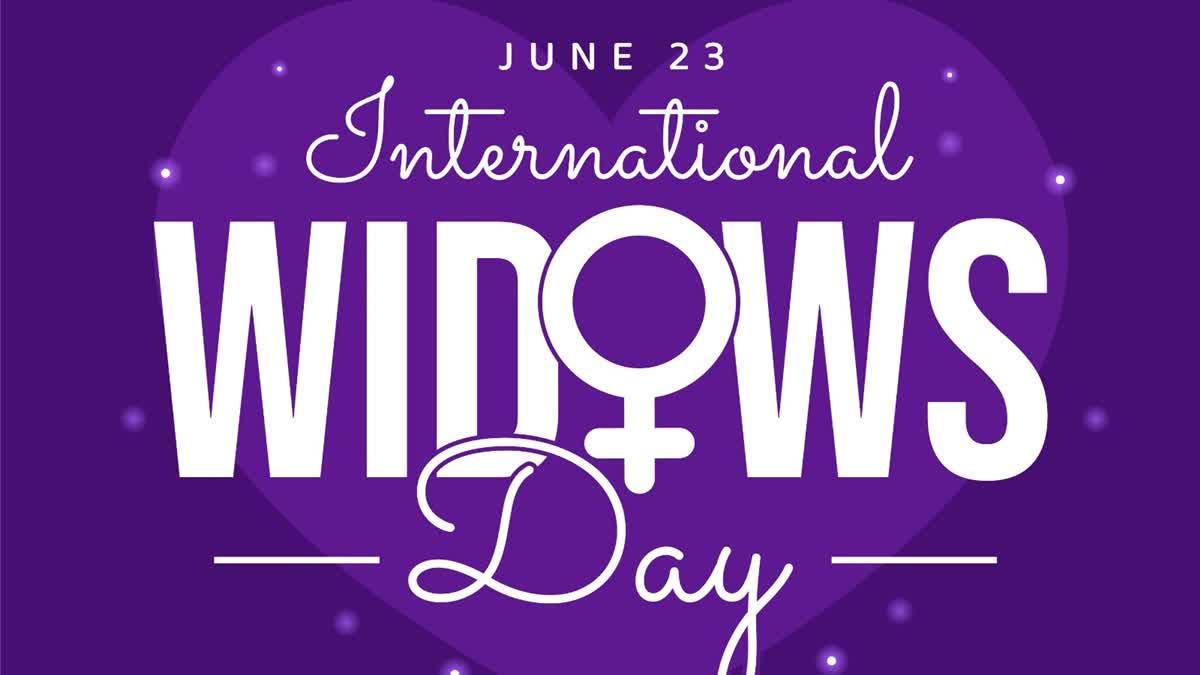International Widows' Day 2024: History and Significance
The International Widows' Day 2024 which is being observed on Sunday, is a day to recognize the rights of widows around the world and to create awareness in this regard for the welfare of this section of the society. According to statistics, there are about 258 million widows in the world with nearly one in 10 widows living in extreme poverty.


Published : Jun 23, 2024, 7:00 AM IST
Hyderabad: For many women around the world, the devastating loss of a partner is magnified by a long-term fight for their basic rights and dignity. Every year on June 23, which is observed as the International Widows' Day, special recognition is given to the situation of widows of all ages across the globe on. According to recent statistics, there are about 258 million widows in the world. Nearly one in 10 widows live in extreme poverty. This is because many widows don't have access to credit or other economic resources, including work.
Experience from the past, shows that widows are often denied inheritance rights, have their property grabbed after the death of a partner, and can face extreme stigma and discrimination, as perceived ‘carriers’ of disease. Worldwide, women are much less likely to have access to old age pensions than men, so the death of a spouse can lead to destitution for older women. In the context of lockdowns and economic closures, widows may not have access to bank accounts and pensions to pay for healthcare if they too become ill or to support themselves and their children. With lone-mother families and single older women already particularly vulnerable to poverty, this is an area that needs urgent attention.
History of International Widows' Day
The International Day of Widows was officially declared by the United Nations (UN) on 21 December 2010 by passing a resolution called "In Support of Widows and Their Children". The history of International Widows Day has its roots from the Loomba Foundation located in the United Kingdom. The foundation is a charitable trust founded by Lord Raj Loomba which works on an international level for empowerment of widows.
Background
International Widows' Day was initiated by the Loomba Foundation in 2005. The plight of widows world-wide has been the foundation's focus since it was established in 1997. According to its founder, Raj Loomba, women in many countries experience great hardship after their husbands die. “They are not looked after by governments or NGOs and they are shunned by society.” The observance falls on June 23 because Loomba's mother became a widow on that date in 1954.
Significance of International Widows’ Day
The day is important as it brings about awareness among the public the problems that widows face all over the world. It is a time to reflect on the progress that has been made, and to celebrate acts of courage and determination by ordinary women.
It is also a day to draw the attention of the people to take action and provide full rights and recognition for widows.
It spreads awareness about the challenge the widows face. The day helps to find ways to help the widows globally. The policymakers of the national governments are not acknowledging the hardships of the widows.
The widows are ignored consciously by the policymakers. This day triggers the policymakers to provide equal opportunities for widows across the globe.
It breaks the traditional stigma that widows are outcastes, rejects the idea that widows bring misfortune and creates the awareness against the stigma that widows are a waste of society or are a burden on national wealth.
The Hindu Widows' Remarriage Act, 1856 : Highlights
Marriage of Hindu widows legalized.
Rights of widow in deceased husband's property to cease on her marriage.
Guardianship of children of deceased husband on the remar-riage of his widow.
Nothing in this Act to render any childless widow capable of inheriting.
Saving of rights of widow marrying, except as provided in sections 2 to 4.
Ceremonies constituting valid marriage to have same effect on widow's marriage.
Consent to remarriage of minor widow.
Condition of Widows Before the Introduction of the Act
According to the prevalent customs in some parts of India, widows, especially upper caste-Hindu widows were expected to lead a life of austerity and extremities.
Widows remarriage was not permitted even if she was a child and the marriage was not even consummated. Widows had to wear a white saree of coarse material. In many cases, she had to shave off her hair and was not even allowed to wear a blouse.
They were boycotted from festivals and even shunned by members of the family and society.
Ishwar Chandra cited Hindu scriptures to show that widow remarriage was well within the folds of Hinduism. Through his efforts, Lord Canning enacted the Widow Remarriage Act throughout British India.
Major changes after the Establishment of the Act
As per the law: “No marriage contracted between Hindus shall be invalid, and the issue of no such marriage shall be illegitimate, by reason of the woman having been previously married or betrothed to another person who was dead at the time of such marriage, any custom and any interpretation of Hindu Law to the contrary notwithstanding.”
The law also held that widows who remarry were entitled to all the rights and inheritances that a woman who marries for the first time would have.
As per the act, the widow forfeited any inheritance that she may have obtained from her deceased husband.
The act also provided legal safeguards to men who married widows.
Widow remarriage was, however, commonplace among people of the lower castes.
This act was a watershed in the social reformation of Indian society during the nineteenth century.
The first widow remarriage that took place after the law was enforced took place on 7th December 1856 in north Calcutta. The groom was the son of Ishwar Chandra’s close friend.
Schemes for Welfare of Widows in India
The Indira Gandhi National Widow Pension Scheme (IGNWPS), introduced in the year 2009, provides BPL (Below Poverty Line) widows in the age group 40 to 59 (Non- Resident ofAndaman can’t apply this service).
Home for Widows: A Home for Widows has been set up in Vrindavan, UP with a capacity of 1000 inmates to provide widows a safe and secure place of stay, health services, nutritious food, legal and counseling services.
Antyodaya Anna Yojana(AAY):Department of Food and Public Distribution implements Antyodaya Anna Yojana (AAY),under which rice and wheat at a highly subsidised cost, is extended to households, headed by widows/terminally ill/disabled persons/senior citizens, with no assured means of maintenance or societal support.
Senior Citizens' Welfare Fund: In pursuance of the Budget Announcement, 2015- 16, this welfare fund has been created to be utilized for such schemes, for promoting financial security of senior citizens, health care and nutrition of senior citizens and welfare of elderly widows.
Problems for widows in developing countries
Poverty
No access to credit or other economic resources, even for childcare or education.
No rights or limited rights, to inheritance or land ownership under customary and religious law.
Dependent on the charity of their husbands’ relatives.
Disowned by relatives and made homeless in countries like India, forcing many women to seek informal work as domestic labourers or turn to begging or prostitution.
In some cases, widows can become liable for the debts of a deceased spouse.
Violence
Particularly across Africa and Asia, widows find themselves the victims of physical and mental violence – including sexual abuse – related to inheritance, land and property disputes.
Widows are coerced into participating in harmful, degrading and even life-threatening traditional practices as part of burial and mourning rites. In a number of countries, for example, widows are forced to drink the water that their husbands’ corpses have been washed in. Mourning rites may also involve sexual relations with male relatives, shaving of the hair and scarification.
Health
Poor nutrition, inadequate shelter and vulnerability to violence, combined with a lack of access to health care.
Sexual and reproductive health needs of widows may go unaddressed.
Widows are particularly vulnerable in the context of HIV and AIDS. Women may be kept unaware of the cause of their husband’s AIDS-related death and made to undergo ritual cleansing through sex with male relatives regardless of HIV status. The economic insecurity stemming from widowhood also drives some women and girls to sex work.
Conflict-related situations
Vast numbers of women are widowed due to armed conflict. In some parts of eastern Democratic Republic of the Congo, for instance, it is reported that around 50 per cent of women are widows, while there are an estimated three million widows in Iraq and over 70,000 in Kabul, Afghanistan.
Widows struggle to care for themselves and their children in their own countries, refugee camps or countries of asylum.
Trauma during and after the conflict: many women see their husbands tortured, mutilated or suffering other cruel and inhuman treatment. Widows may themselves be subject to discrimination or conflict-related violence – including sexual violence where they are raped, mutilated, or infected with HIV.
Facts About Widows
After losing their spouse, widows often face issues like discrimination, stigmatization, economic problems, and harmful traditional practices.
Some countries deprive widows of their basic rights like inheritance. They are expelled from their houses and even separated from children. According to UN, "It is estimated that nearly one in ten widows worldwide lives in extreme poverty."
At least 1.36 million of the approximately 258 million widows globally are child widows, but the true number is likely higher due to under-reporting, reported by United Nations.
In some nations, Widows are labelled as carriers of diseases and cursed and are forced to perform ethical cleansing and some harmful religious practices.
A recently released data by the Ministry of Defence (MoD), shows the number of widows in every state, Punjab being on top of the list with 74,253 women, which makes up 10.63 per cent of the total number of widows. Punjab has been marked as the state where the most number of widow women reside; not just the widows of war veterans, but the overall highest number of widows.
After Punjab, nationwide, Kerala ranks the second with 69,507 widows and Uttar Pradesh ranks third with 68,815 widows. The lowest number of widows are recorded in Andaman and Nicobar with 192 widowed women.





